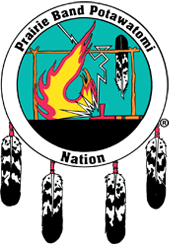December 05, 2011 –
Follow up on President Obama meeting with Tribal Leaders
In a web post released today from the White House, on December 2, 2011, following the2011 White House Tribal Nations Conference, President Obama met with a small and regionally diverse group of tribal leaders from across Indian Country including Prairie Band Potawatomi Nation Chairman Steve Ortiz. Also participating in the meeting were Secretary of the Interior Ken Salazar, Secretary of Health and Human Services Kathleen Sebelius, Secretary of Education Arne Duncan, and Associate Attorney General Thomas Perrelli.
The tribal leaders in attendance had the opportunity to directly engage with the President on a leader-to-leader, government-to-government basis. They spoke about economic issues affecting their reservations and proposed some innovative solutions for developing sustainable economies focusing on building solar and wind projects, reducing regulatory burdens, expanding broadband and leveraging private sector investment, among others. Also discussed was the Executive Order on Improving American Indian and Alaska Native Educational Opportunities and Strengthening Tribal Colleges and Universities, which the President signed earlier in the day to improve education opportunities for Native American youth across the country.
The twelve tribal leaders that participated in the meeting besides Ortiz were Fawn Sharpe, President, Quinault Indian Nation; Diane Enos, President, Salt River Pima-Maricopa Indian Community; Jefferson Keel, Lt. Governor, Chickasaw Nation; Nelson Cordova, Governor, Pueblo of Taos; George Edwardson, President, Inupiat Community of Arctic Slope; Ben Shelly, President, Navajo Nation; Richard Milanovich, Chairman, Agua Caliente Band of Cahuilla Indians; Colley Billie, Chairman, Miccosukee Indian Tribe; Tracy “Ching” King, President, Fort Belknap Indian Community; Rodney Bordeaux, President, Rosebud Sioux Tribe; and Erma Vizenor, Chairwoman, White Earth Band of Chippewa.
This meeting took place after a week of White House events that focused on strengthening the government-to-government relationship between the United States and Tribal Nations and building on the progress made during the 2009 and 2010 White House Tribal Nations Conferences. In addition to the President’s meeting, the White House hosted a series of Regional briefings and listening sessions for tribal leaders, highlighted 11 Native American youth as Champions of Change, released a White House Tribal Nations Conference Progress Report and at the Tribal Nations Conference the President spoke to representatives from the 565 federally recognized Indian tribes.
